Все способы:
- Способ 1: Отключение фоновых приложений
- Способ 2: Удаление мини-приложений
- Способ 3: Отключение виджетов
- Способ 4: Очистка автозагрузки
- Вариант 1: Раздел «Автозагрузка» в «Параметрах»
- Вариант 2: «Диспетчер задач»
- Способ 5: Очистка кеша оперативной памяти
- Способ 6: Отключение открытия приложений после перезапуска
- Способ 7: Использование режима максимальной производительности
- Способ 8: Установка драйверов и обновлений для них
- Способ 9: Проверка системных обновлений
- Способ 10: Проверка компьютера на наличие вирусов
- Способ 11: Очистка и дефрагментация жесткого диска
- Способ 12: Отключение индексирования поиска
- Способ 13: Апгрейд ОЗУ
- Вопросы и ответы: 0
Способ 1: Отключение фоновых приложений
Фоновым приложением в Windows 11 может стать практически любое установленное, если для него настроен автозапуск и соответствующие разрешения поведения, добавляемые по умолчанию. Каждая программа, которая находится в фоновом режиме, всегда потребляет какое-то количество оперативной памяти, пускай даже и незначительное. Для оптимизации ОЗУ рекомендуется проверить, есть ли на вашем ПК работающие фоном программы. Если покажется, что какие-то из них можно отключить, непременно стоит сделать это, ведь данная операция исключительно положительно повлияет на количество освобожденной оперативной памяти и ее быстродействие в операционной системе.
Подробнее: Как отключить фоновые приложения в Windows 11
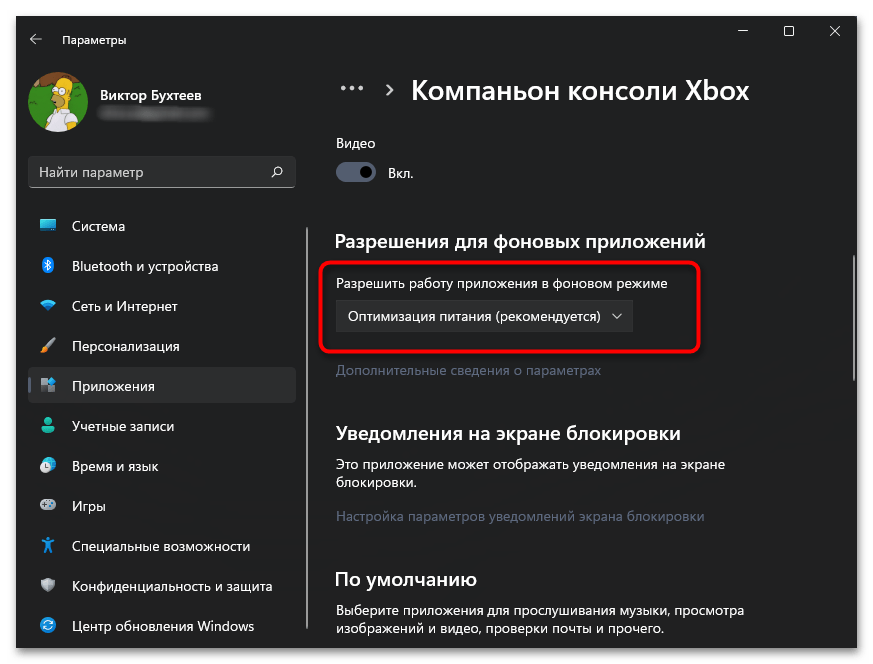
Способ 2: Удаление мини-приложений
Разберем еще один метод, который тоже может помочь, если вы обнаружили, что оперативную память занимают стандартные приложения Windows 11. К ним зачастую относятся различные мини-приложения, установленные по умолчанию и недоступные для удаления стандартным методом. Отключить их вряд ли получится, поэтому можно только удалить выборочно или пакетно, что зависит от вашей ситуации. Рекомендуем удалять только те мини-приложения, которые действительно всегда открыты и использовать их вы не собираетесь. Более детально об этом читайте в отдельном материале на нашем сайте по следующей ссылке.
Подробнее: Удаление мини-приложений в Windows 11
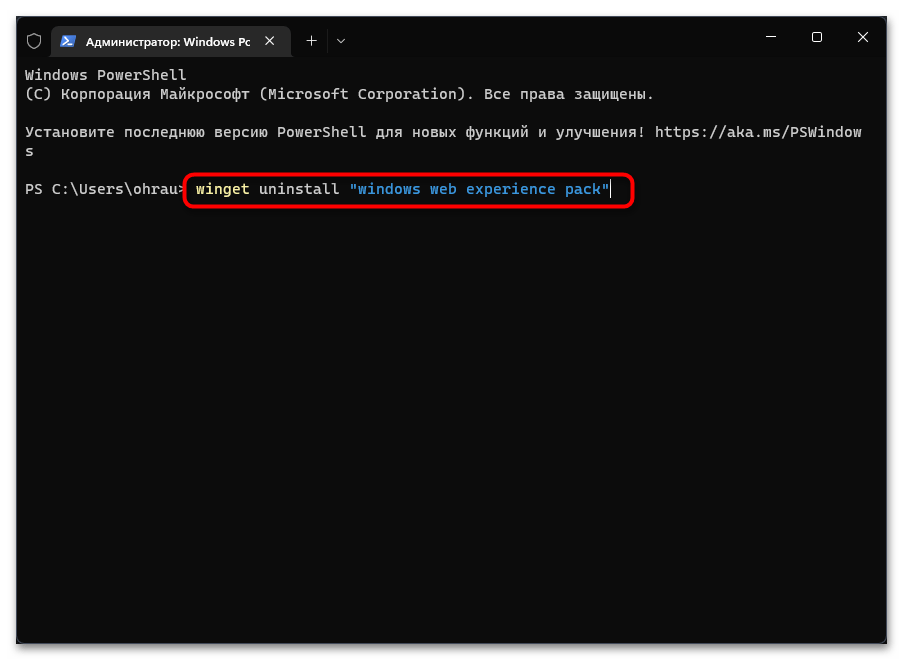
Способ 3: Отключение виджетов
К виджетам в Windows 11 отчасти относятся как мини-приложения, так и дополнительные плитки на самой панели, отображающие самую разную информацию из интернета. Конечно, для ее загрузки и показа используются определенные ресурсы компьютера даже в тот момент, когда сами плитки свернуты. Вы можете отключить работу мини-приложений или разобраться с каждым виджетом, оставляя только необходимые. Это не сильно скажется на нагрузке оперативной памяти, но может помочь немного разгрузить ее, особенно когда речь идет об ее постоянной нехватке.
Подробнее: Как отключить виджеты в Windows 11
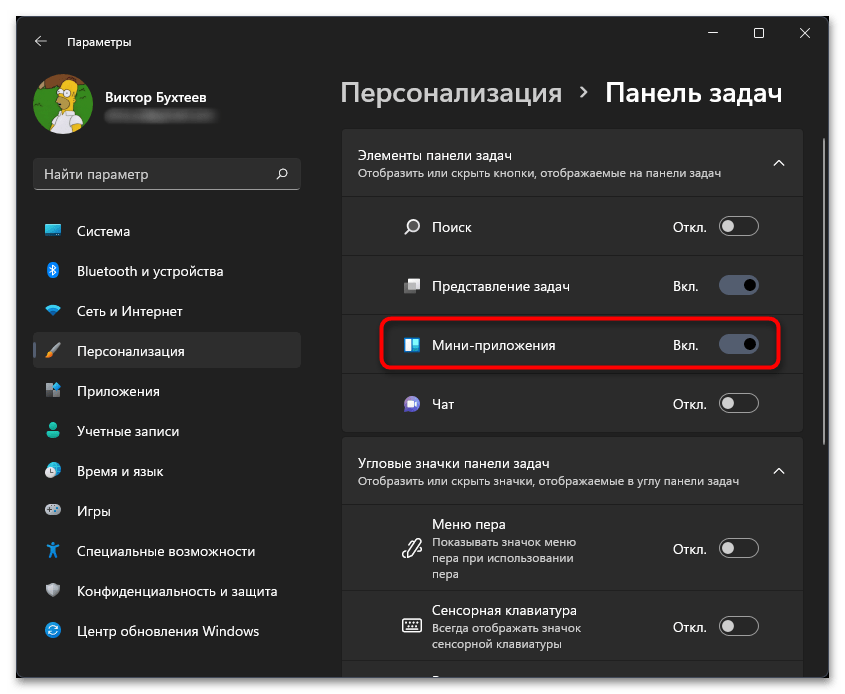
Способ 4: Очистка автозагрузки
Автозагрузка — специальная функция в операционной системе, позволяющая некоторым программам стартовать и работать в активном режиме сразу при запуске операционной системы. Разные сторонние программы особенно активно функционируют и потребляют довольно много оперативной памяти, даже если вы ими не пользуетесь или не видите окно на рабочем столе. Для оптимизации ОЗУ мы бы настоятельно рекомендовали проверить, какой софт включается автоматически и какой можно отключить. Рассмотрим два самых популярных варианта выполнения настройки.
Вариант 1: Раздел «Автозагрузка» в «Параметрах»
Приложение «Параметры» в Windows 11 отлично подходит практически для любых настроек. В нем есть и специальный раздел для управления программами, в котором можно найти список автозагрузки, быстро ознакомиться с ним и решить, что можно отключить. Для этого следуйте простой инструкции.
- Откройте меню «Пуск» и найдите в списке закрепленных значков «Параметры».
- В новом окне на левой панели выберите «Приложения» и перейдите к разделу «Автозагрузка».
- Ознакомьтесь со списком отображаемых приложений и решите, что из этого вам не нужно. Для отключения автозагрузки конкретной программы перетащите ее переключатель в состояние «Откл.». Повторите то же самое с остальными, после чего перезагрузите ПК и проверьте, уменьшится ли нагрузка на ОЗУ.
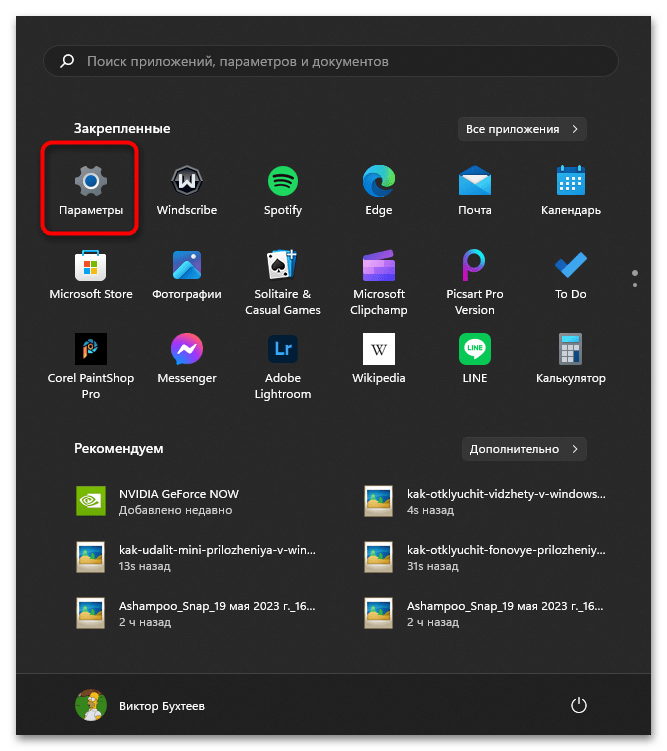
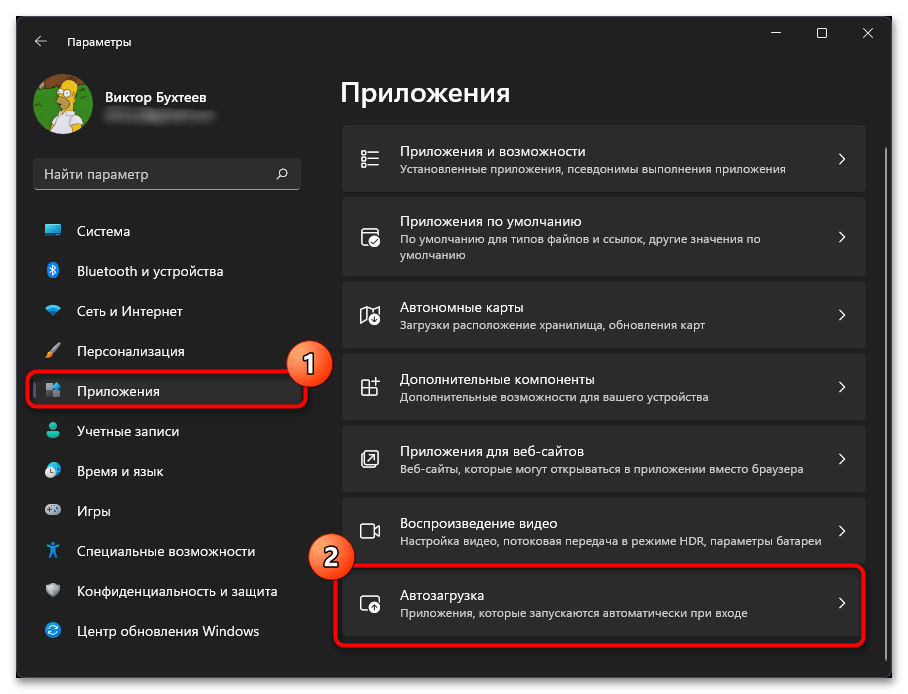
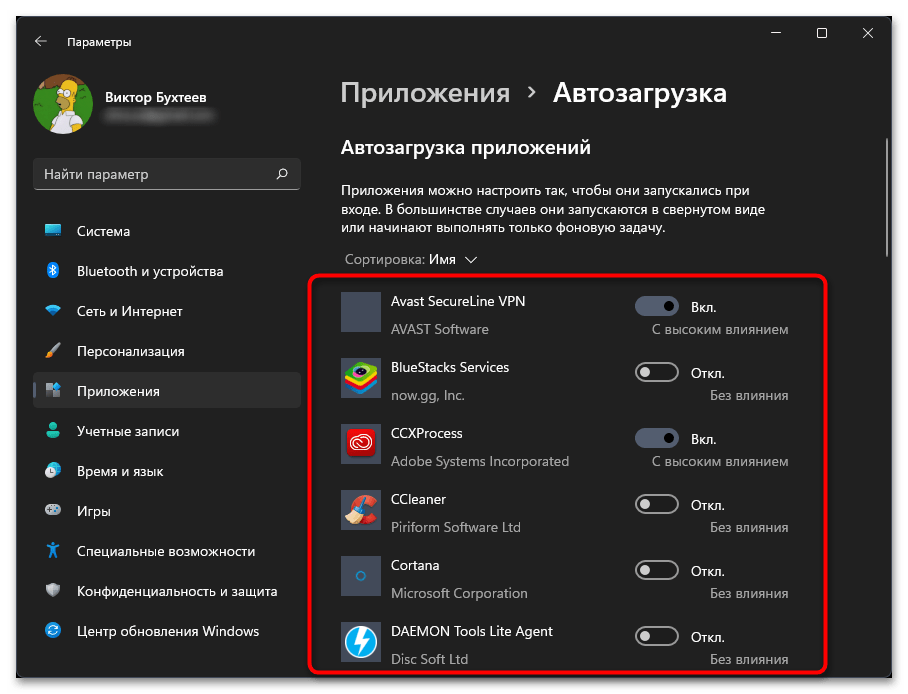
Вариант 2: «Диспетчер задач»
Через «Диспетчер задач» можно не только отследить нагрузку на комплектующие и управлять различными процессами, но и узнать программы автозагрузки, а также убрать их из нее, если это понадобится. Все действия происходят в рамках одного окна, поэтому вам не придется тратить на это много времени.
- Щелкните правой кнопкой мыши по «Пуску» и из появившегося контекстного меню выберите пункт «Диспетчер задач».
- Перейдите на вкладку «Автозагрузка» и ознакомьтесь с состоянием отображаемых там программ.
- Если какую-то захотите отключить, выделите ее левой кнопкой мыши и используйте кнопку с соответствующим названием справа внизу.
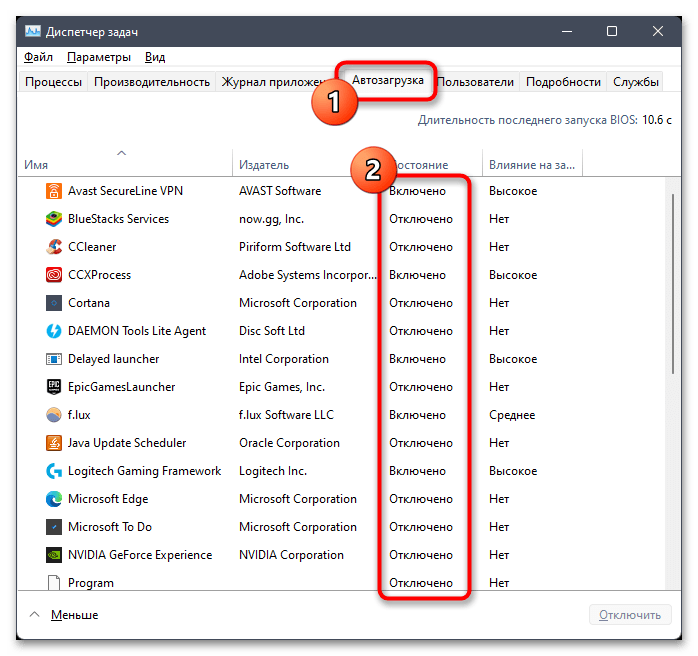
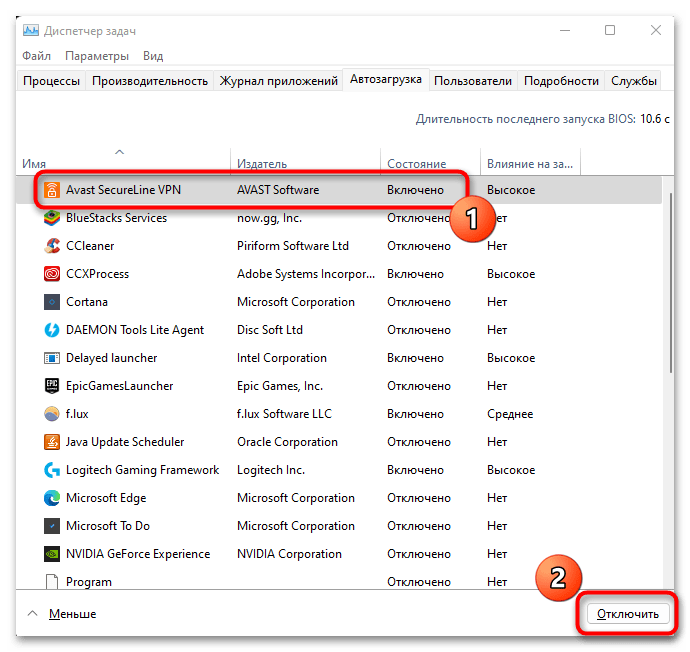
Способ 5: Очистка кеша оперативной памяти
Кеш оперативной памяти необходим для быстрого повторного запуска ранее открытых программ и различных процессов, если те были завершены. Обычно кеш очищается автоматически при перезагрузке ПК или через некоторое время, однако из-за ошибок и различных системных сбоев это может не произойти. В результате пользователь получает не только забитое пространство, но и заполненность самого кеша, что приводит к замедлению быстродействия ПК. Для очистки можно использовать как стандартное средство Windows, так и дополнительные программы, о чем более детально читайте в статье ниже.
Подробнее: Очистка кеша оперативной памяти в Windows
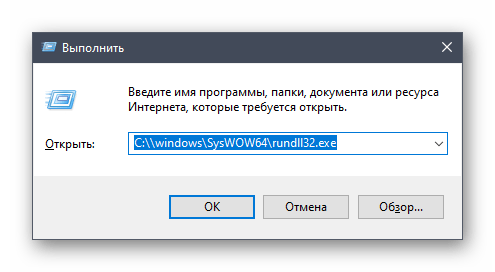
Отметим, что в представленном материале рассказано было не обо всех программах, к тому же есть и такие, которые обладают другим подходом к очистке оперативной памяти, затрагивая различные системные службы и временные файлы. Обзоры на них вы можете найти в тематическом материале далее, а после ознакомления решить, подойдет ли что-то из предложенного для оптимизации ОЗУ на вашем компьютере.
Читайте также: Программы для очистки оперативной памяти
Способ 6: Отключение открытия приложений после перезапуска
В Windows 11 есть функция, связанная со входом в аккаунт, что чаще всего происходит в разных сеансах операционной системы. Она предполагает сохранение состояния приложений при выходе и возвращении их изначального состояния при перезапуске. То есть вы можете не выключать программы, а просто завершить работу за компьютером, а при следующем старте все приложения откроются в том же месте и будут доступны для работы. Такая функция потребляет значительное количество оперативной памяти в активном режиме, поэтому для оптимизации ее можно отключить, если вам не нужно сохранять состояние приложений.
- Через «Параметры» перейдите к разделу «Учетные записи», где выберите «Варианты входа».
- Перетащите переключатель у пункта «Автоматически сохранять мои перезапускаемые приложения из системы и перезапускать их при повторном входе» в состояние «Откл.». Теперь вы можете отправить компьютер на перезагрузку и проверить, поможет ли данное действие немного оптимизировать работу ОЗУ.
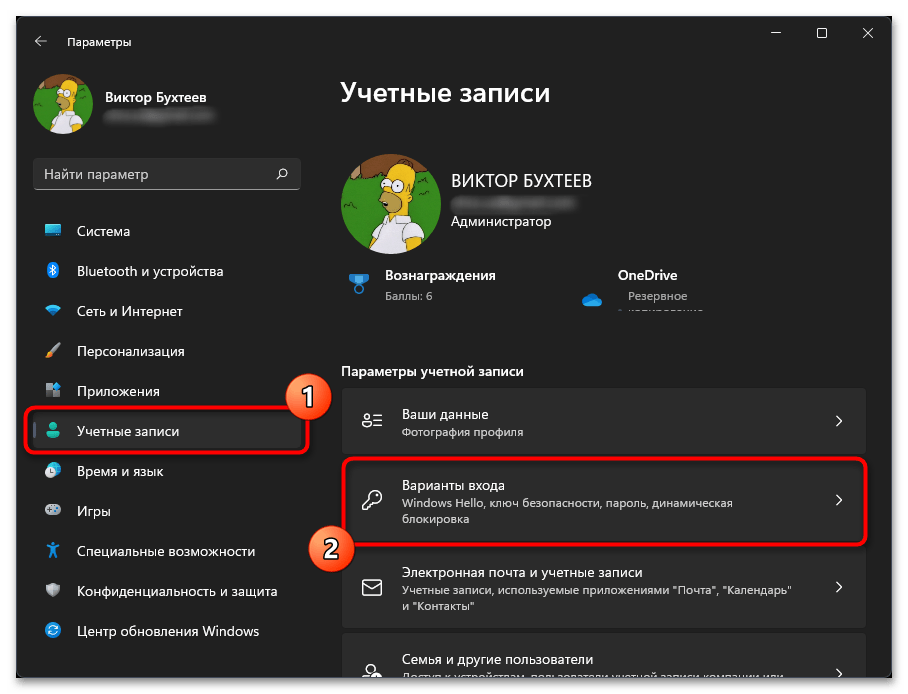
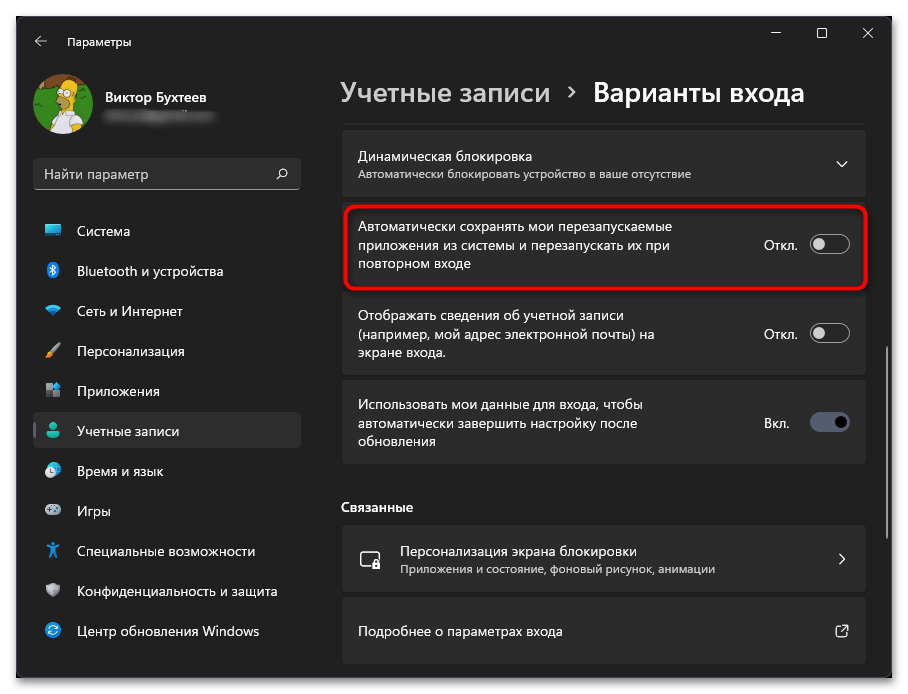
Способ 7: Использование режима максимальной производительности
Режим максимальной производительности — один из стандартных планов электропитания для компьютеров или ноутбуков под управлением Windows. Он подразумевает отсутствие любых ограничений для работы комплектующих в плане снижения нагрузки с целью уменьшения электропотребления. Как раз он и позволяет использовать, в том числе, и оперативную память на полную мощность. Благодаря этому режиму убирается любое ограничение на частоты, а также повышается скорость отклика процессора, что тоже важно при работе с программами. О том, как включить данный режим максимальной производительности, читайте в другой статье, кликнув по следующему заголовку.
Подробнее: Использование режима максимальной производительности в Windows 11
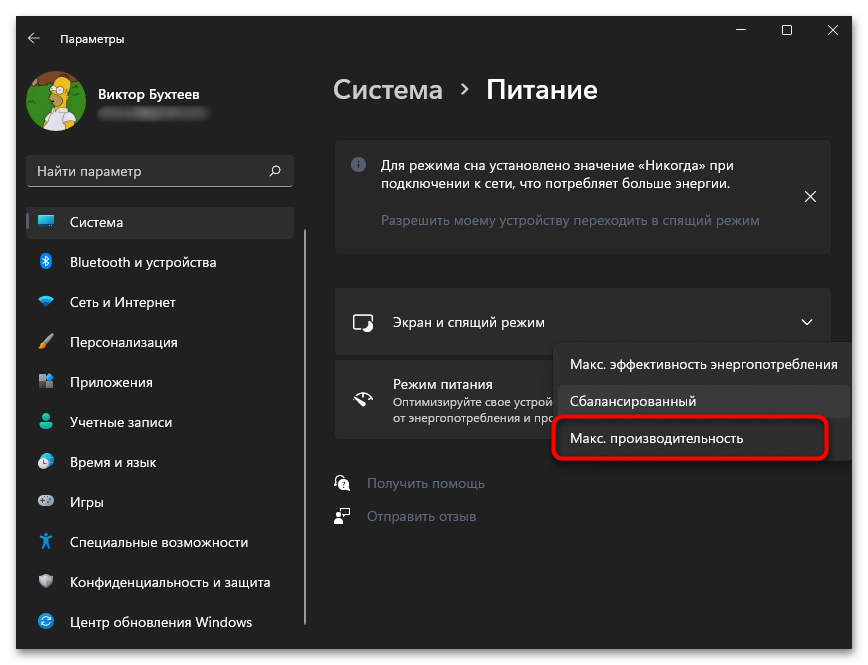
Способ 8: Установка драйверов и обновлений для них
Конкретно драйверов для оперативной памяти как таковых не существует, однако есть вспомогательные, предназначенные для чипсета материнской платы и других связанных компонентов. Наличие всех необходимых драйверов и обновлений для них комплексно оптимизирует работу операционной системы, повышая и быстродействие оперативной памяти. Поэтому мы настоятельно рекомендуем проверить все это вручную или при помощи специальных программ.
Подробнее: Установка драйверов в Windows 11
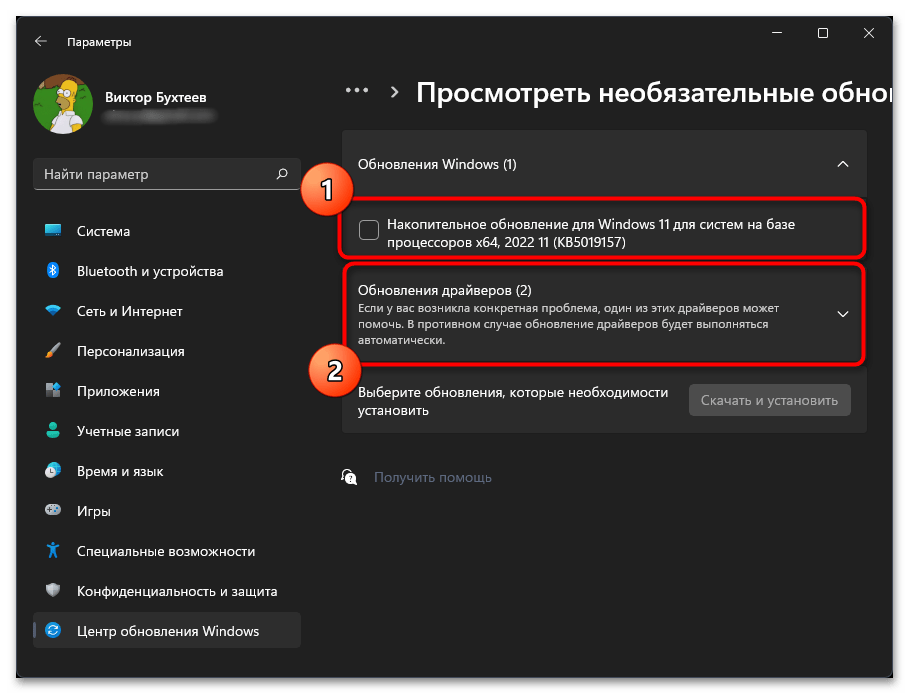
Способ 9: Проверка системных обновлений
Наличие всех актуальных обновлений для Windows 11 косвенно влияет на оперативную память, поскольку может помочь оптимизировать общую производительность и отклик программ с процессами. Однако при комплексном подходе к решению задачи проверка апдейтов является практически обязательным пунктом, к тому же это не отнимет у вас много времени и сил.
- В «Пуске» нажмите по значку с шестеренкой, чтобы перейти в «Параметры».
- На панели слева выберите раздел «Центр обновления Windows» и нажмите кнопку «Проверить наличие обновлений».
- Ожидайте окончания сканирования и ознакомьтесь с результатами. Если апдейты были найдены, запустите их скачивание и установку, после чего перезагрузите компьютер для применения изменений.
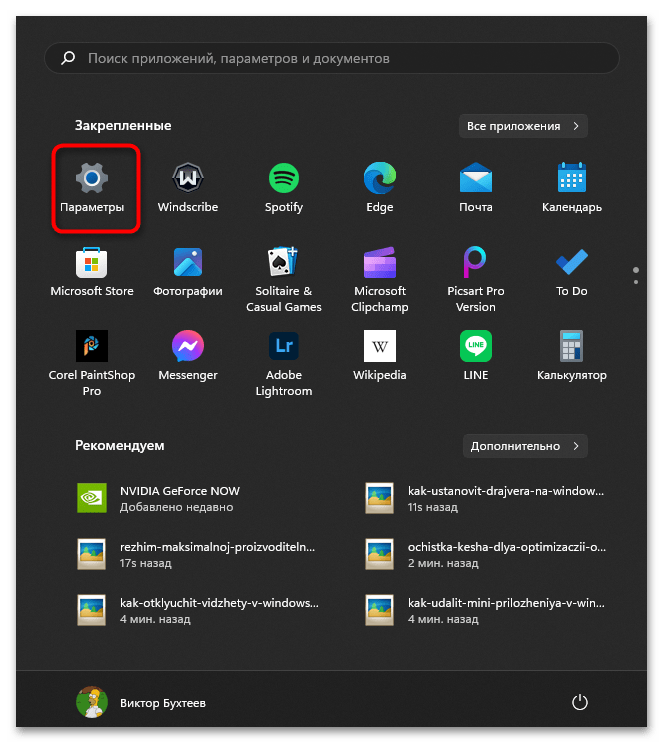


Способ 10: Проверка компьютера на наличие вирусов
Все действия по оптимизации оперативной памяти в Windows 11 могут быть бессмысленны, если компьютер заражен вирусами. Вредоносное ПО может потреблять значительное количество ОЗУ и замедлять выполнение различных процессов. Именно поэтому одна из рекомендаций заключается в регулярной проверке ПК на наличие вирусов. Вы можете настроить автоматическое сканирование в определенное время через сторонние антивирусы или стандартную защиту. Это остается исключительно на ваш выбор, как и подбор подходящего софта.
Подробнее: Борьба с компьютерными вирусами
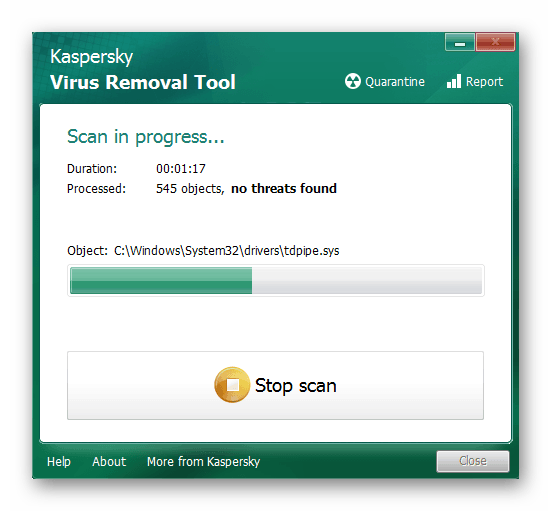
Способ 11: Очистка и дефрагментация жесткого диска
Следующий совет лишь косвенно связан с оперативной памятью и ее оптимизацией, поскольку подразумевает прямую работу с жестким диском. Нужно освободить память и удалить временные файлы, что позволит немного или даже значительно повысить быстродействие. Это поможет и оперативной памяти обрабатывать запросы быстрее, поскольку не придется ждать долгого отклика от жесткого диска.
Подробнее: Очистка системного (C:) диска в Windows 11
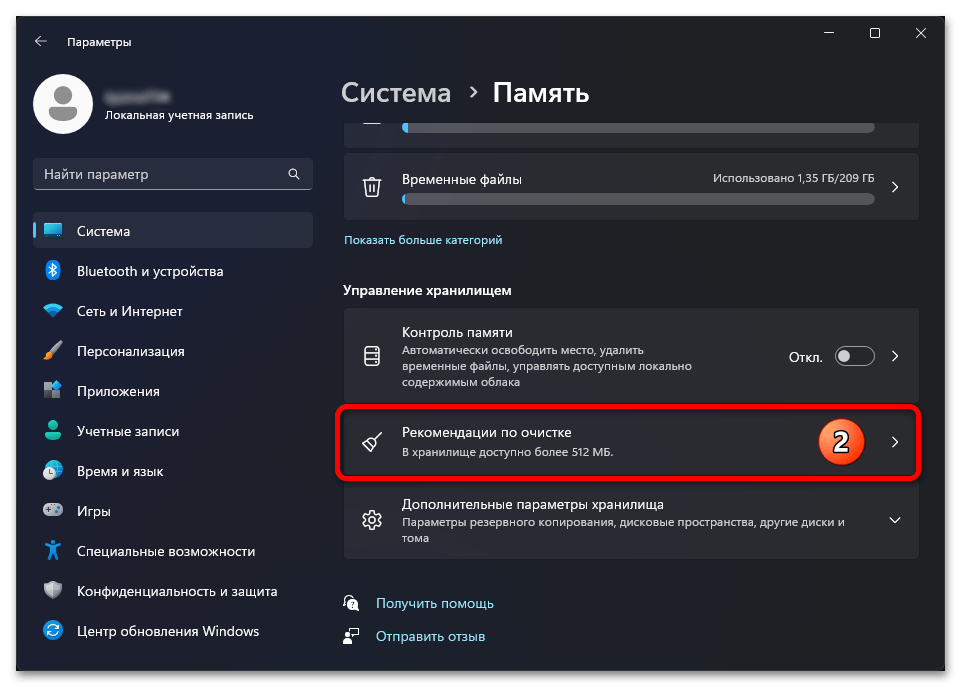
Дефрагментация нужна в тех случаях, когда вы уже давно пользуетесь диском и не запускали эту процедуру ранее. Она подразумевает перераспределение пространства, чтобы при считывании файлов диску не нужно было обращаться к секторам в разных местах, что значительно замедляет процесс чтения. Дефрагментация скажется и на ОЗУ, поскольку вы будете быстрее получать отклик от процессов и файлов.
Подробнее: Дефрагментация дисков в Windows 11
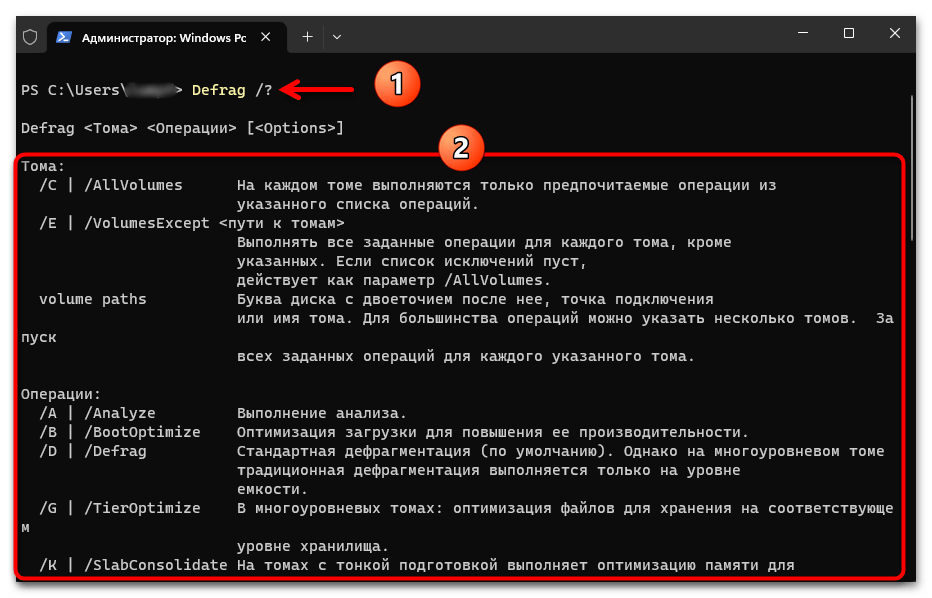
Способ 12: Отключение индексирования поиска
Есть и радикальный метод, позволяющий на несколько процентов улучшить работу оперативной памяти, оптимизируя ее в плане работы с самой системой. Заключается способ в отключении индексирования поиска. Это приведет к тому, что поиск будет работать медленнее, а также поиск по названиям файлов станет недоступен. Однако в целом нагрузка на ОЗУ снизится, и в других аспектах быстродействие повысится.
- Если вы решили отключить индексирование, через поиск в «Пуске» отыщите «Панель управления» и запустите данное классическое приложение.
- В нем выберите раздел «Параметры индексирования».
- В новом окне воспользуйтесь кнопкой «Изменить».
- Снимите галочки со всех существующих расположений, после чего подтвердите изменения и отправьте компьютер на перезагрузку.
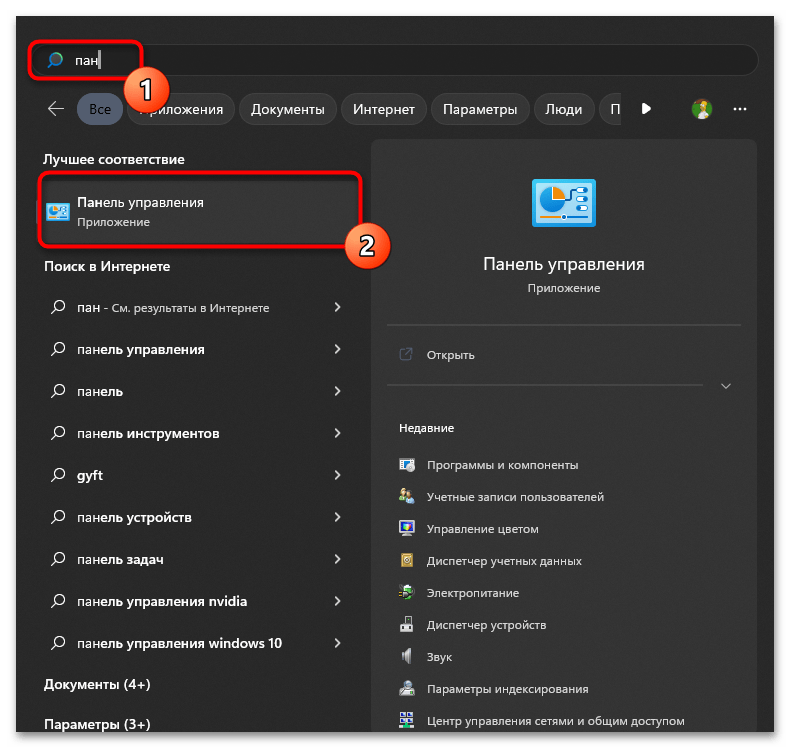
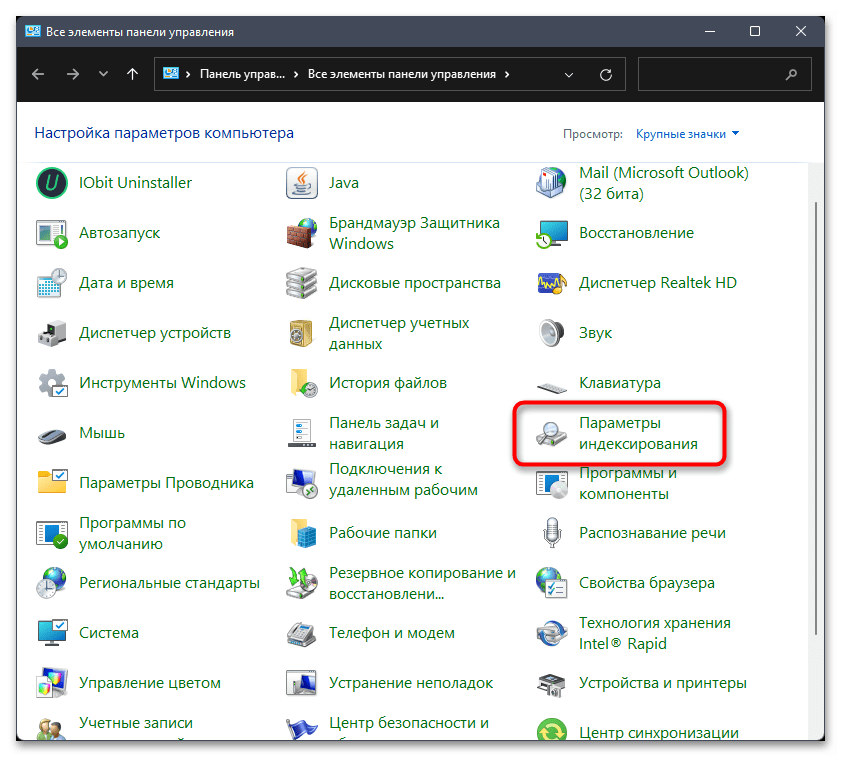

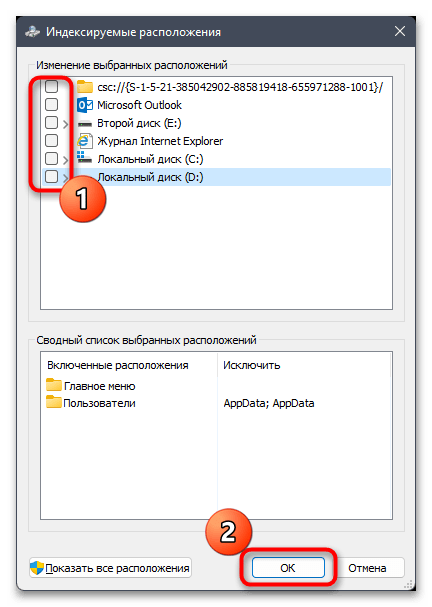
Если при дальнейшем использовании компьютера окажется, что поиск вам все-таки нужен или не удается отыскать нужные файлы без их названий, вы можете точно так же включить индексирование обратно, поставив те же самые галочки. Никаких критических изменений в систему при этой настройке не вносится, поэтому ОС будет работать точно так же, как и раньше.
Способ 13: Апгрейд ОЗУ
Если ничего из перечисленного выше вам так и не помогло оптимизировать работу оперативной памяти, не хватает ее объема или скорость обработки информации слишком маленькая, остается только один выход — апгрейд комплектующего. Вы можете приобрести новые модули или проверить, работают ли текущие в многоканальном режиме. Второй пункт обязателен для соблюдения, если в вашей системе установлено более одной планки с ОЗУ, поскольку это значительно увеличивает производительность.
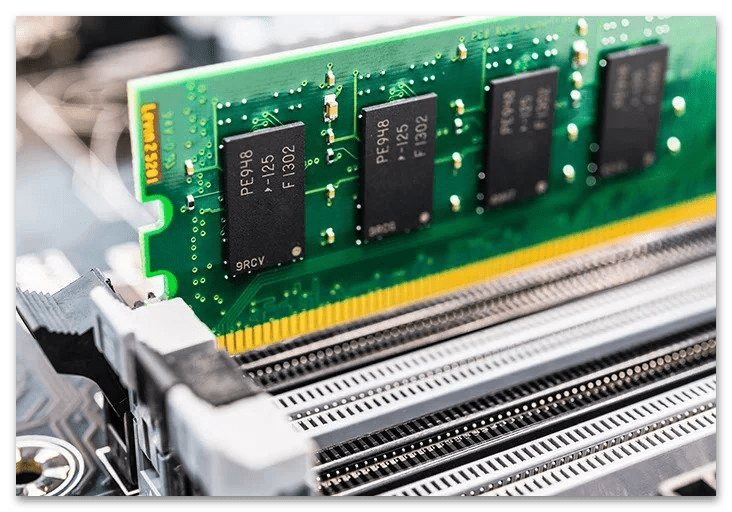
Наша группа в TelegramПолезные советы и помощь
You may notice your Windows 11 system is taking a performance hit, which could potentially lead to a crash, freezing, or not responding issues. This is primarily due to the computer running high on memory usage in some cases. In this post, we will offer ways PC users can free up, reduce, or limit RAM usage on their devices.

Windows 11 ships with many new features and improvements compared to earlier versions of Windows, of which most, if not all, are heavy on system resources. Probably the reason why Microsoft is encouraging Windows 11 installation on supported hardware only, although PC users can install Windows 11 on unsupported hardware. Some PC users may experience high memory usage while running Windows 11 on supported or unsupported hardware with the required minimum specifications.
Now, in some quarters, there are suggestions to disable these new features, but in our opinion, that seems to defeat the purpose of PC users taking advantage of all the bells and whistles that come with a modern OS—otherwise, why upgrade to Windows 11 or newer? The idea is to improve your workflow, gaming experience, or whatever task you choose with the modern OS and achieve more.
Read: Microsoft Edge High Memory Usage
Some of the new features suggested for users to disable includes Microsoft Teams and the Widgets Board, both icons are pinned to the taskbar alongside all the usual options, such as the Start menu and Task View. Widgets and Microsoft Teams chat launch Microsoft Edge WebView2 processes in the background. This process is necessary for web-based apps like Teams or Widgets in Windows 11, but unfortunately, in some cases, these processes are resource-intensive. The WebView2 processes are triggered when you click the Widgets Board icon and browse through the feed. Whereas the Teams chat icon uses system resources whether in use or not, as the icon is pinned to the taskbar, it triggers web-related activities in the background once a user signs in to Windows 11.
Read: Fix msedgewebview2.exe High CPU and Memory usage
So, for those who don’t use these new features daily and want to reduce RAM usage on their device and improve performance, you can simply right-click on both and unpin the icons. This will prevent WebView2 processes from being triggered on startup in the case of Teams. However, you may not notice any significant improvement in your daily usage. Still, it will help to curtail how many concurrent WebView2 processes will be running in the background as you launch more apps or web apps on your device.
For a much better and ideal memory usage management without stripping or disabling new features of Windows 11 on your device, you can try the following suggestions:
- Restart PC
- Make sure Apps and Windows 11 is always up-to-date
- Run malware scan
- Clear Memory cache
- Uninstall or Disable unused apps
- Use Portable or install lighter versions of app OR alternatives
- Enable ReadyBoost
- Run Windows Memory Diagnostic Tool
- Upgrade or install additional RAM.
1] Restart PC
We start off with the obvious: As soon as you notice memory spikes while running Windows 11 on your device, you can give your PC a quick restart to completely clear the contents of RAM and restart all running processes, including those you are not aware are running. You should periodically restart your PC to perform this memory cleanup and also when your PC feels sluggish and you haven’t restarted the device in a while.
Read: Why does restarting your Windows PC fix so many problems?
2] Make sure Apps and Windows 11 is always up-to-date
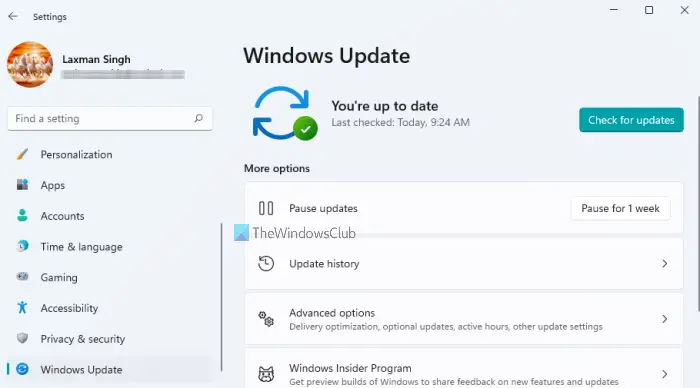
Operating system bugs are known to be voracious system resource hogs. So, it’s recommended for PC users to always ensure that the Windows 11 OS is updated as and when due based on the Windows Update Servicing Cadence. In the same vein, you should always make sure installed apps are updated in a timely manner, and not just for security reasons, as the latest versions of apps can include optimization and improvements such that the app when in use, consumes less RAM in general. An updated app may include a fix for any memory leak issues the app might be having.
3] Run malware scan
In some cases, if your PC is infected by a virus/malware, you’re likely to experience high memory usage. So, make sure the security software installed on your device is fully updated and then manually run a full malware scan to disinfect and get rid of potential rogue software and services or processes consuming memory.
Read: Why is my RAM usage so high when nothing is running?
4] Clear Memory cache
Normally, more memory will be consumed if you have more apps running on your system. Keep in mind that some apps, when launched, trigger multiple processes—and each of these processes takes up memory. So, when not in use, closing the apps may help, but at times, the app still does not release the memory allocated to the process. In this case, clearing the Memory cache and freeing the RAM resources is necessary, which can then be allocated to other processes.
Read: High Disk & Memory Usage when playing Games on PC
5] Uninstall or Disable unused apps
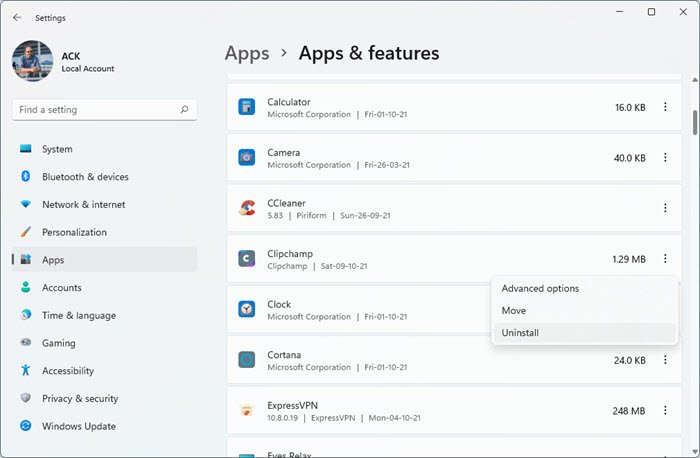
One of the ways to reduce RAM usage is to prevent programs you never use anyway from consuming it. If you have apps you haven’t opened and used in months but still run in the background are potentially consuming memory resources. In this case, you can uninstall those apps. If you don’t want to uninstall an app because you use it sometimes, you can stop the app from opening or running at startup because most apps are set to automatically run every time you log in, which is unnecessary if you rarely use them.
In addition, check and disable browser extensions you don’t use. This is necessary as every extension you add to your browser consumes extra memory, so removing unused extensions is an easy way to reduce RAM usage further on your device.
Read: How to check which app is using more RAM in Windows
6] Use Portable or install lighter versions of app OR alternatives
You may want to clear RAM on your computer, but the apps hogging memory resources are necessary to your workflow. In this scenario, you can try using lighter versions of the app (if available) or the Portable app versions, if available. Alternatively, you can use try using lighter app alternatives when you can. For example, you can try using a smaller app like Paint.NET or GIMP for minor edits and only use Photoshop when you’re fully dedicated to working on a project.
Read: How to reduce Chrome memory usage & make it use less memory
7] Enable ReadyBoost
If the computer you’re running Windows 11 on is old and has less RAM, you can use ReadyBoost. However, this feature is of limited use today because if your computer has an SSD, ReadyBoost won’t make any improvements performance-wise. This is because an SSD is faster than a flash drive, so the paging file is more efficient than using the USB drive as RAM. Moreover, PCs ship with more RAM by default, so there won’t be any noticeable gain compared to an old machine with an HDD installed.
8] Run Windows Memory Diagnostic Tool
Run the Windows Memory Diagnostic Tool. This tool can be used to check for possible memory problems, including testing your computer’s Random Access Memory (RAM). It helps you figure out bad memory and memory issues and usually takes 20 minutes to complete.
9] Upgrade or install additional RAM
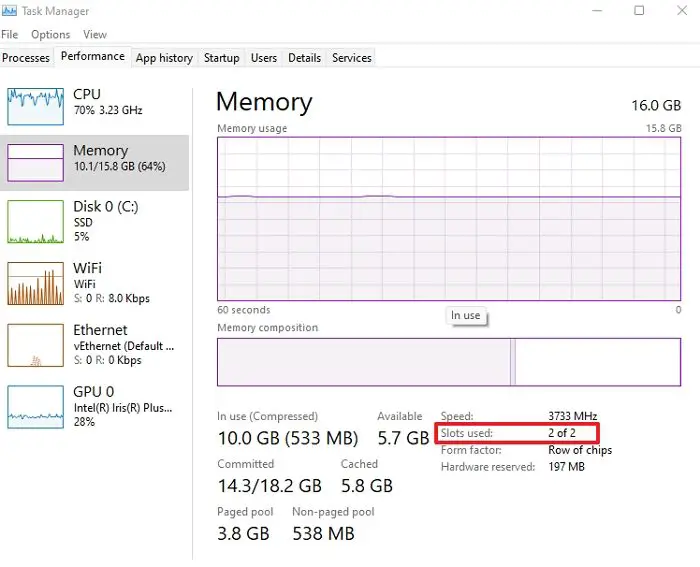
We leave this as the last option as this does involve some cost; but adding RAM will surely improve performance, especially if you’re always running low on RAM or want to run more programs simultaneously. You may also require the services of a hardware technician, although adding RAM on a desktop is fairly easy compared to a laptop with a confined space. In any case, you’ll need to check for free Memory slots and make sure you purchase RAM compatible with your system. You can refer to your PC manufacturer’s documentation or search online.
Read: The biggest Myths about RAM that many people have
I hope you find this post informative and helpful!
Related post: How to Check, Lower or Increase CPU usage in Windows
How do I make Windows 11 use less RAM?
To make Windows 11 use less RAM, try the following suggestions:
- End all unnecessary apps and services
- Disable the unnecessary Startup apps
- Defragment your Hard Drive
- Disable SysMain Service
- Adjust for best Performance
Why is my RAM usage so high?
All computer memory is connected to the CPU and RAM. However, the high memory usage problem is mainly due to the overcrowding of many internal processes. A general fix for this issue is to open Task Manager and check for and stop the running unnecessary programs and applications.
How much RAM usage is normal?
Generally, 4GB is starting to become “not enough,” while 8GB is fine for most general-use PCs (with high-end gaming and workstation PCs going up to 16GB or more). And what percentage of RAM is considered normal? For a computer running on Windows, the average usage of 15-30% is expected at idle. This percentage is due to the reserved memory of the OS, its drivers, and different applications, along with the cached data.
Read: Free Memory Optimizers & Cleaners for Windows PC
Is Windows 11 RAM hungry?
It will not be completely unusable if you have a 4GB system with Windows 11 installed. But you will notice that at least 3 GB of RAM is being used by system processes, or 70-80 percent of RAM is being used without any programs.
Windows 11, the newest version of the Microsoft operating system, comes with many exciting features, making it a big improvement from Windows 10. But, some users are dealing with a problem of high RAM or memory usage. This issue happens because of different reasons, making Windows 11 not work as well as it could on laptops and PCs.
If you’re one of those facing this problem and want to boost your computer’s performance or increase your laptop’s RAM, you’re in the right spot. You can go through these effective solutions to reduce memory usage in Windows 11. You can also look at what is Memory Usage on Windows and how to check Memory Usage on Windows 11. Just follow the whole article to make your PC work better without hassle.
What Is Memory Usage on Windows?
Memory usage on Windows is the amount of random access memory (RAM) that is currently being used by the operating system, applications, and other processes. RAM is a type of volatile memory that is used to store data that is being actively used by the computer. When the computer is turned off, all of the data in the RAM is lost.
However, upon restarting or booting up the system, background services, operating system functions, and actively running applications begin to utilize the available RAM.
If the memory usage percentage is excessively high, it can lead to performance issues such as slow responsiveness, lags, or even system freezes.
Therefore, balancing and managing memory usage in Windows is fundamental for ensuring an efficient and smooth computing experience. Regularly monitoring memory usage can help you prevent performance degradation.
How to Check Memory Usage on Windows 11
There are a few different ways to check memory usage on Windows. One way is to use Task Manager. To open Task Manager, press Ctrl + Shift + Esc. In Task Manager, click the Performance tab. Under Memory, you can see how much RAM is currently being used and how much RAM is free.
Another way to check memory usage is to use Resource Monitor. To open Resource Monitor, press Windows + R to open the Run dialog box. Type resmon and press Enter. In Resource Monitor, click the Memory tab. You can see a more detailed view of memory usage on this tab, including which processes are using the most RAM.
High RAM usage can be a common problem in Windows 11, especially if you have a lot of programs running at the same time. If you’re experiencing high RAM usage, it can cause your computer to slow down and become unresponsive.
There are a few things you can do to fix high RAM usage in Windows 11, and we’ll discuss some of the most common solutions in this article.
1. Restart PC
One of the easiest and most effective ways to resolve excessive RAM usage in Windows 11 is to simply restart the computer. It can address various issues and reduce excessive RAM consumption. When you restart your computer, it shuts down all currently active programs and background processes. This effectively refreshes your system, stopping any tasks that use a lot of memory and are causing the computer to use too much RAM.
As your PC restarts, it releases the memory that was previously allocated to various applications. This action can help free up valuable RAM and ensure a more seamless experience. Follow the below steps to do so.
1. Click the Start Menu.
2. Click on the Power icon, and then select Restart.

2. Update Windows 11
Restarting your computer might have helped you, but if you still notice that your PC is using high RAM, making sure your operating system is up to date can make a big difference. Regular system updates not only make your computer run better but also can solve problems related to RAM. Windows 11 updates include bug fixes and optimizations for better resource management. These updates can resolve software issues that contribute to high RAM usage.
Keeping your operating system updated is also essential for security reasons. This helps keep your system safe from potential problems that can slow it down. Follow the steps below to check for Windows 11 updates.
1. Press the Windows + I button simultaneously to open Settings.
2. In the Settings window, select Windows Update.

3. Click Check for updates and follow the on-screen instructions to download and install any available updates.

3. Uninstall Unused Apps
You might be facing a shortage of RAM in your Windows 11 for various reasons, and one of the primary reasons is the accumulation of numerous unnecessary apps over time. Even if you rarely use these applications or don’t use them at all, they continue to occupy a significant portion of your computer’s RAM.
Many of these apps are configured to automatically launch every time, which is unnecessary if you rarely use them. This continuous auto-start contributes to the excessive consumption of RAM. That’s why uninstalling these unused apps is crucial to free up storage space and improve your PC’s RAM situation.
Here’s how you can uninstall apps on Windows 11:
1. Open Settings.
2. Navigate to the Apps section on the left-hand panel.
3. Select Installed Apps from the options available on the right-hand panel.

4. Upon clicking Installed Apps, all the applications on your PC will appear in the window. Here, locate the applications that you wanna uninstall.
5. Then, click the three-dot icon and select Uninstall from the menu popup.

6. A confirmation dialog will appear. Click Uninstall again to proceed with the uninstallation.

4. Close Unnecessary Apps and Services
If you’ve tried the previously mentioned methods to fix high RAM usage in Windows 11 and still face the same issues, it may be because of unnecessary apps and services running in the background.
When you open numerous apps and services that you don’t frequently use, they continue running in the background, consuming your PC’s storage and, importantly, RAM. This can be a significant drain on your system’s resources. However, you can regain control and free up precious RAM by ending these unnecessary apps and services using the built-in Windows Task Manager.
Here’s how you can close unnecessary apps and services using the Task Manager:
1. Press Ctrl + Shift + Esc on your keyboard simultaneously to open Task Manager.
2. In the Task Manager window, click on the Processes tab, and then click on the Memory column to sort the processes by memory usage, with the highest consumers listed first.
3. Now, look for apps and services you don’t need at the moment or are using excessive RAM. Common examples might include background applications related to software updates, unnecessary browser tabs, or applications you’ve opened but aren’t actively using.
4. Right-click on the unnecessary apps and services.
5. Then, click the End Task option from the pop-up menu.

5. Run Windows Memory Diagnostic
Is your Windows 11 computer experiencing issues like slow performance, freezing issues, hanging, blue screen errors, or unexpected reboots? These problems can sometimes be attributed to memory issues, particularly with your computer’s Random Access Memory (RAM).
To identify and diagnose such problems, Windows 11 provides a built-in tool called the Windows Memory Diagnostic Tool. It is a valuable tool that can help you identify and address potential memory problems on your PC.
Here are the steps to run the Windows Memory Diagnostic Tool:
1. Press the Windows key + R to open the Run dialog box.
2. Type mdsched in the search field, and hit OK.

3. A window pop-up will appear with two distinct options.
4. Here, click on Restart now and check for problems option to run the memory diagnostic.

Your computer will restart, and the Windows Memory Diagnostic Tool will begin running. The test will take several minutes to complete as it performs two different tests, so please be patient.
Once the test is complete, your computer will restart, and you will see a notification with the test results. You can also view the results in Event Viewer. To learn more, you can check out our guide on how to use the Windows Memory Diagnostic Tool.
If the test detects any errors, you will need to contact your computer manufacturer or a qualified technician to replace the faulty RAM module.
6. Disable Startup Apps
You can boost your Windows 11 computer’s performance and free up RAM by taking control of unnecessary startup apps. These are the applications that automatically launch when you restart your computer. While some apps are essential for your workflow, many of them are superfluous and can be easily disabled.
You can even customize your list of startup apps to include the ones you frequently use. This way, you can have your preferred apps ready to go as soon as your computer boots up.
Let’s explore how to manage these startup apps and ensure your system runs efficiently.
1. Open the Windows Settings app.
2. Click on Apps in the left sidebar and click on Startup in the right pane.

3. Toggle off the switch next to the apps you don’t want to start at startup.

Using the above steps, you can control the Startup apps and reduce RAM usage on your Windows 11 system.
7. Disable SysMain Service
The SysMain service, known as Superfetch, is a Windows service that monitors how you use your computer and preloads frequently used applications and data into memory. This can improve the startup and load times of your applications.
However, the SysMain service can also use a significant amount of CPU and disk resources, especially when it is first running. If you are experiencing performance problems with your computer, you may want to consider disabling the SysMain service.
Here’s how you can disable the SysMain service:
1. Press the Windows key + R to open Run.
2. Here, type services.msc and press Enter.

3. Scroll down and double-click on the SysMain from the lists of services.
4. Then, click the Stop button to stop the service.

8. Adjust for Best Performance
Adjusting the best performance will disable some of the visual effects in Windows 11 and it may help to smoothly run the PC. For example, you may notice that windows no longer fade in and out when you open and close them. You may also notice that fonts are not as smooth as they were before. But it will also help to improve performance on older or less powerful computers.
Follow the steps below to adjust for the best performance in Windows 11
1. Open the Start menu and search for Performance.
2. Click on Adjust the appearance and performance of Windows option.

3. Click on the Visual Effects tab and select Adjust for best performance.
4. Now, to apply and save the changes, click on the Apply and OK button.
5. After that, Restart your PC.

9. Change Registry Key
The Windows Registry is a powerful tool that can be used to optimize your system’s performance. Changing the registry key is also an important method to fix high RAM usage in Windows 11. It is important to note that changing registry keys can be dangerous, follow the steps very precisely and only change keys that you are familiar with. Do not change what a key does if you are unsure.
1. Press Windows key + R to open Run.
2. Here, type regedit and press Enter to open the Registry Editor.

3. A confirmation pop-up will appear saying Do you want to allow this app to make changes to your device. Press Yes if you want.
4. Navigate the HKEY_LOCAL_MACHINE registry key and expand SYSTEM > CurrentControlSet > Control.

5. Furthermore, expand Session Manager > Memory Management.
6. In the right-hand pane, double-click the ClearPageFileAtShutdown registry key.

7. Click on Modify from the menu that appears.

8. Change the value data to 1 and select base as Hexadecimal.
9. Then, click OK to save the change.
10. After that, close the Registry Editor and restart your computer.

10. Check for Virus
If you continue to experience the same issue, there’s a significant possibility that your PC has viruses, which can result in high usage of memory or RAM. To address this, you should promptly scan and remove any viruses from your computer.
Here are some steps you can follow to eliminate these threats from your system. To check for viruses in Windows 11, you can use Windows Security, which is Microsoft’s built-in antivirus software.
Let me show you how you can check for viruses using Windows Security:
1. Click on the Start button.
2. It will open the Start menu, type Windows Security, and open it.

3. Click on the Virus & threat protection tab and then click on the Quick Scan button. However, if you want to perform a full scan, click on Scan options.

4. Here, select Full Scan and click on the Scan Now button.

Windows Security will scan your computer for viruses and other malware. If any threats are found, Windows Security will prompt you to remove them.
11. Upgrade or Install Additional RAM
After following all the above methods, if you are still facing high RAM usage on Windows 11, you might need to upgrade or install additional RAM modules on your system. As the installed RAM modules may not be sufficient enough to handle processes on your system.
However, adding physical RAM requires purchasing compatible modules and installing them on your laptop or PC. After upgrading or installing RAM modules, you should see an effective boost and improvement in performance to a certain extent fixing high RAM usage.
Conclusion
The suggested methods for fixing RAM usage in Windows 11 should have helped you resolve the issue. After that, check the memory usage to identify the status of your RAM and the reasons behind its high usage.
If any of the fixes did not work, you might also consider upgrading or installing additional RAM in your Windows 11 system.
Have you upgraded from Windows 10 to Windows 11? Windows 11 do give us some surprise but some of you may encounter the high memory usage issue. So how to fix it and make your computer keep healthy? In this article, we provide 8 methods to fix high memory usage in Windows 11.
Quick Navigation:
1. End Unnecessary Apps or Programs
2. Disable Startup Apps
3. Defragment Hard Drive
4. Disable SysMain Service
5. Adjust for Best Performance
6. Increase Virtual Memory
7. Set Your Registry
8. Scan Virus
Reasons for High Memory Usage In Windows 11
Memory is used to temporarily store data and instructions, like RAM. All programs in a computer are run in Memory.
- Unnecessary Apps or Programs
- Enabled a lot of programs running at the Startup.
- Virtual memory is not enough.
- Virus infection.
- More……
The memory usage issue corresponds to a number of approaches, and you may need to try each one of them. Read on and check 8 fixes in Windows 11.
1. End Unnecessary Apps or Programs
Step 1. Press the Search icon in the middle of the taskbar. And input Task Manager, then click the best match to start.
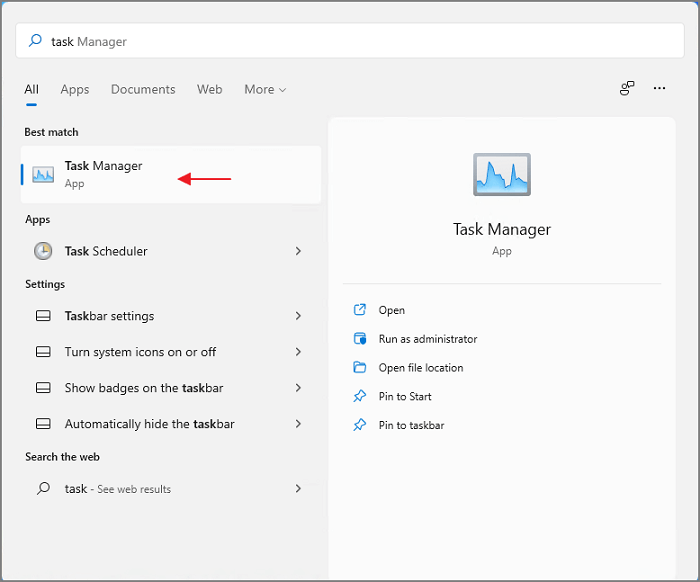
Step 2. In the Task Manager, click the Processes tab.
You can see the apps and programs that are running below. Move to the Memory column, you can see the memory consumption.
Step 3. Right-click the program and select End Task on the pop-up menu.
Choose the app that you don’t need at that moment. Or you can select the one that occupies too much memory.

2. Disable Startup Apps
Some programs will automatically start up when you running the computer. It does convenient for reducing the clicking steps but some apps consuming a lot of memory. The startup is too high. If you want to manage programs running at the Startup, you can go to the Startup tab to disable apps.
Step 1. Click the Search icon to input Task Manager. Click it to launch.
Step 2. Go to the Startup tab.
You can see a bunch of apps that running at the startup.
Step 3. Right-click the app and click Disable.
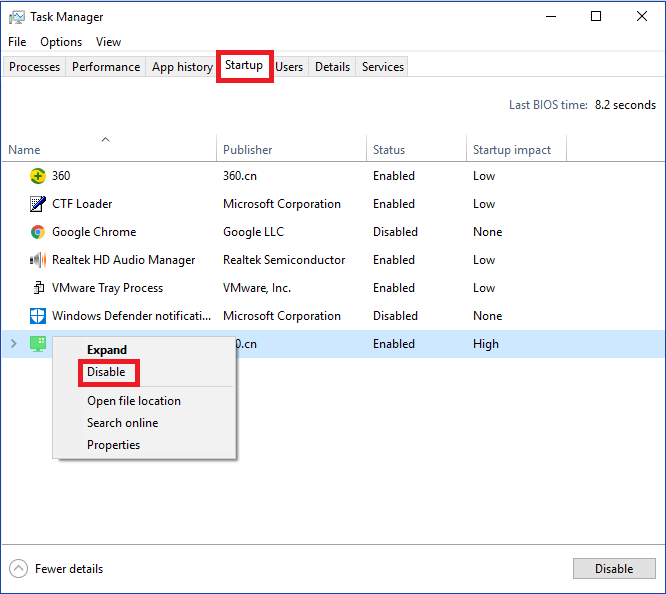
3. Defragment Hard Drive
Step 1. Click the search icon to open the Start menu, and search for Defragment and Optimize Drives. Click the best match result to start.
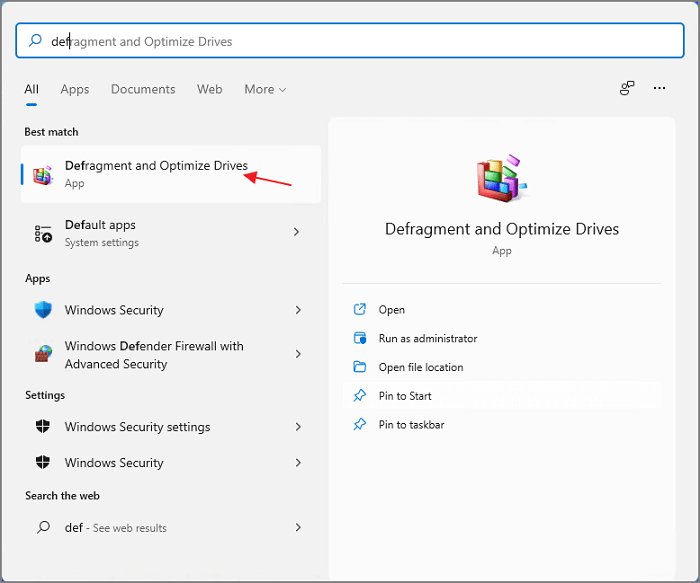
Step 2. You can see the drive here. Click the one you want to defragment and click Optimize option.

Step 3. Wait for the defragment is finish.
Step 4. While finish, restart your computer and see if your memory usage is a relief.
4. Disable SysMain Service
If you are experiencing performance issues, it is OK to disable the SysMain service. Known as SuperFetch in Windows 10, SysMain used to identify the frequently used apps and help you start faster.
Step 1. Press Windows + R to open the Run window. Input services.msc in the box and then click the OK button.

Step 2. Scroll down to find the SysMain service.

Step 3. Right-click SysMain Service and select Properties from the context menu.
Step 4. On the SysMain Properties page, navigate to Startup Type. Click the drop-down menu and choose Disabled.

Step 5. Move to Service status and click the Stop button.
Wait for the disable process to complete and click OK.
5. Adjust for Best Performance
Change the system performance setting also can fix the high memory usage.
Step 1. Open Start menu and search for sysdm.cpl. Click the best match results.
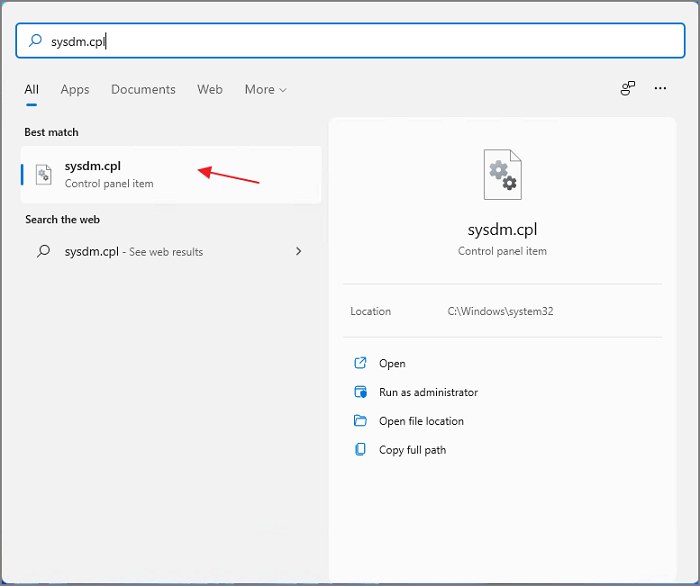
Step 2. You can see the System Properties window here.
Step 3. Click on the Advanced tab and click the Settings button under the Performance.
Step 4. Then the Performance Options windows pop up, select the Adjust for best performance.

6. Increase Virtual Memory
Step 1. Launch Start Menu and type sysdm.cpl. Click the results to move on.
Step 2. When System Properties appear, go to the Advanced tab and click Settings under Performance.

Step 3. In the Performance Options window, click the Advanced tab. And navigate to Virtual memory and click the Change button.

Step 4. Check the Automatically manage paging file size for all drives > select C drive (system partition) > Check No paging file > Click on the Set button.
Step 5. Click Yes to confirm.
Step 6. Select another volume from the drive list > Tick the Custom size and enter a value on Initial size and Maximum size > Click on Set and then click on OK.
Step 7. Restart your computer.
7. Set Your Registry
Step 1. Press Windows + R to open the Run window, type Regedit to open the Registry Editor.
Step 2. Navigate to: Computer\HKEY_LOCAL_MACHINE\SYSTEM\CurrentControlSet\Control\Session Manager\Memory Management
Step 3. Locate and double-click the ClearPageFileAtShutDown.
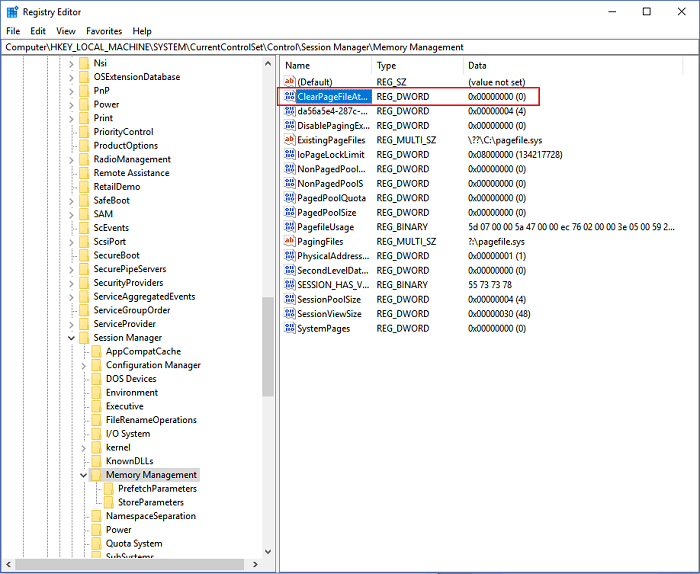
Step 4. Enter 1 on the Value data and click OK.

Step 5. Restart your computer.
8. Scan Virus
The high memory usage may be caused by a virus issue.
Step 1. Type Windows Security on the Start Menu. Click the best match to open the program.
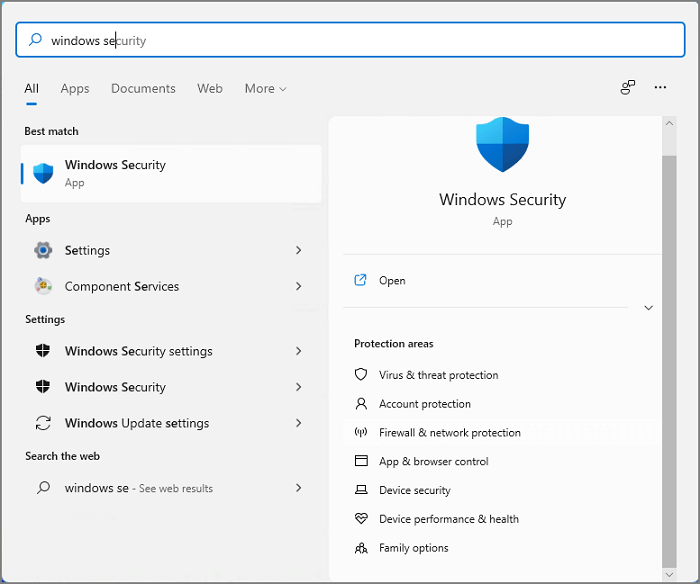
Step 2. Click Virus & threat protection.
You can click the Quick Scan here.
If it doesn’t work, we suggest you make a full scan for looking at the virus.
Step 1. Click Scan options.

Step 2. Tick the Full scan and click Scan now button.

